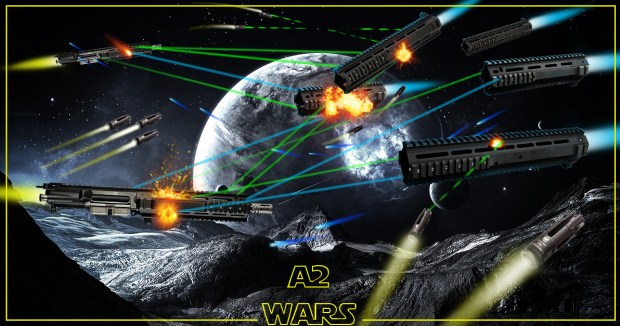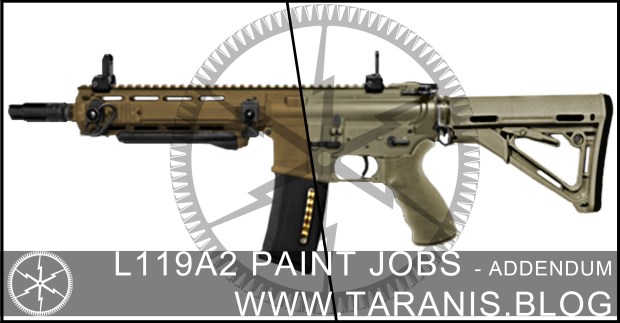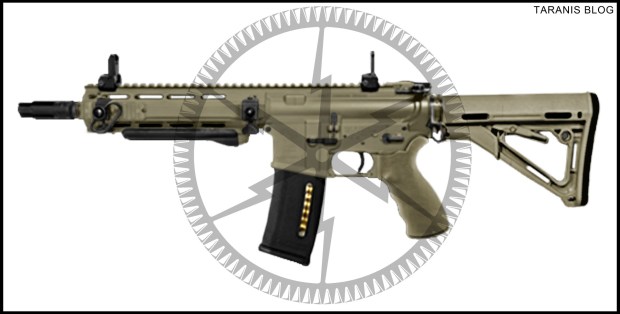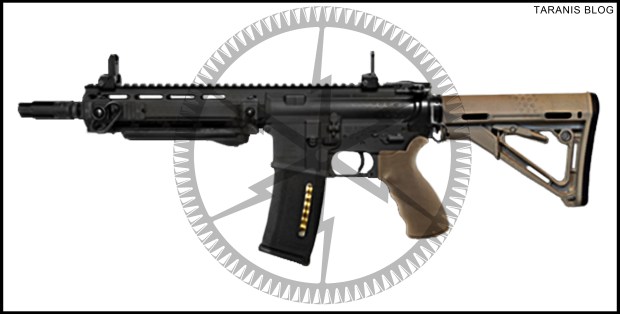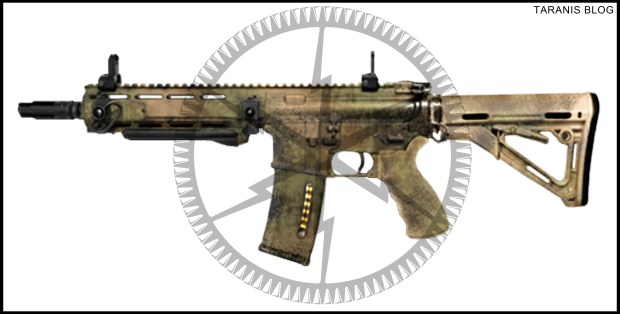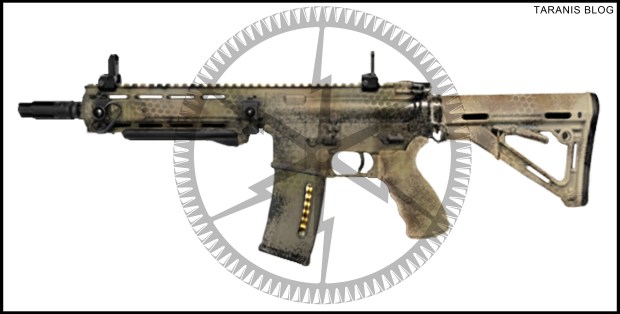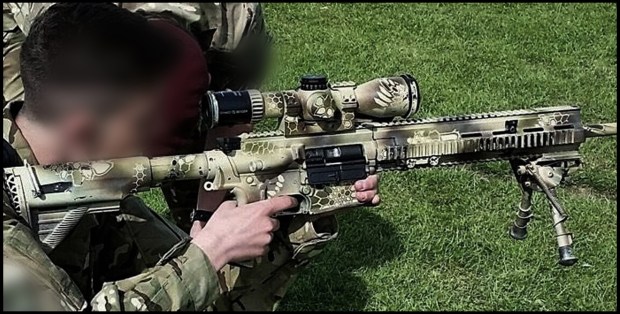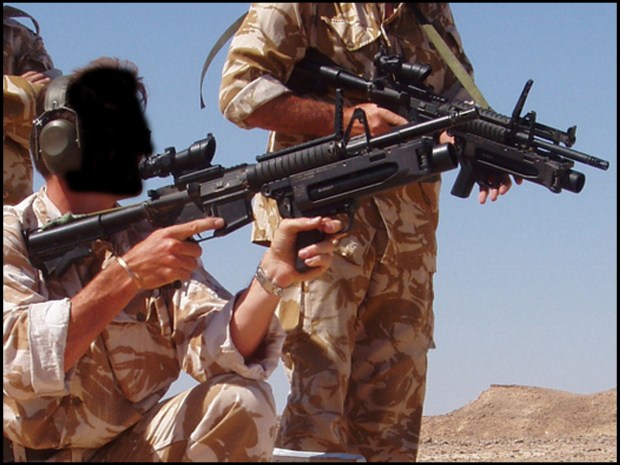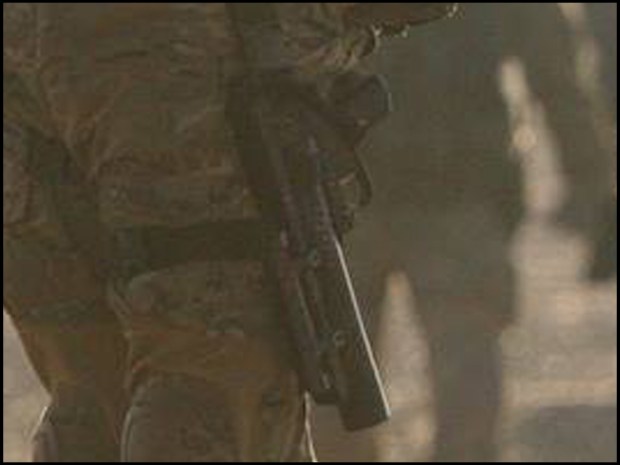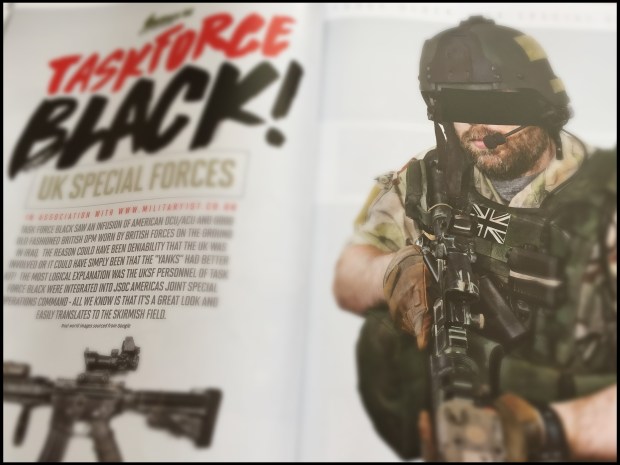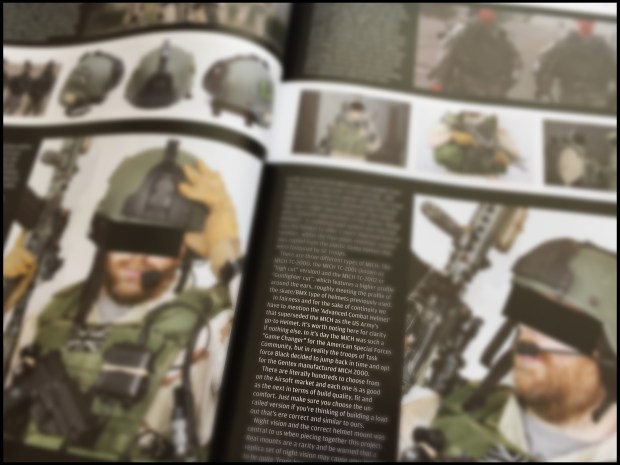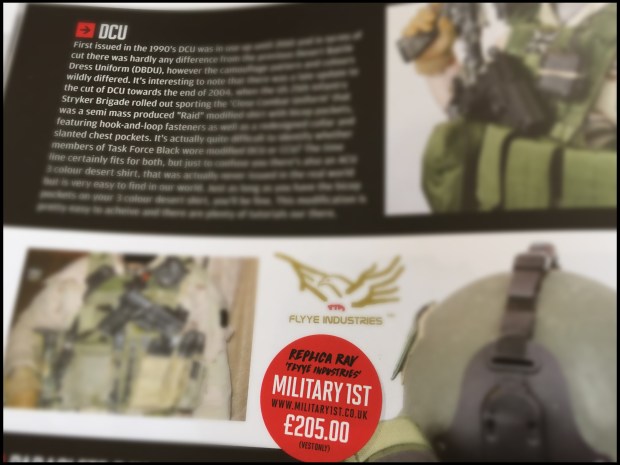A long time ago,
In a galaxy far, far away,
There were only L119A1 builds…
The recently completed L119 Owners Club build competition (Check out The Reptile House Blog’s post here) has given me a little opportunity to take stock on where the L119 build scene is. The incredibly high standard of entries and the care and craft of the builds was staggering, and judging it alongside Rich and Andy was a fun and interesting experience.
But casting my mind back to when I first started on the L119 build route, it was a different story… This one is long, as ever, TL:RD at the bottom.
G&P was probably the ‘standard’ build, they were good solid AEGs, and you could fit them out with the following:
– A G&P C8A1 body (This had the Diemaco badge but ‘C8’ makings), or a Dragon Red L119A1 marked body.
– A Guarder Storm Grip’
– A VFC PEQ-15 was the best about – before the FMA and later Element LA5’s were available. G&P PEQ-2s were also in vogue.
– A repro Surefire flash hider with a murky OEM.
– A PerrMike suppressor. These suppressors were initially somewhat rough and ready but the later generations were solid, well build and surprisingly well detailed. They directly threaded onto a barrel, with flushed or recessed options. No trades however, the weld line was a simple raised ring about the body.
– If you were really lucky you might snag a real Diemaco DIS or even a real UKSF spec KAC RAS.
– When building a SFW upper you would want an exceptionally sought after Army Code reinforced front sight and either Pro Arms or Perr Mike barrel extension. If you couldn’t source these it was a milliput job.
Obviously there were other options, PTWs with Prime receivers and GBBRs, a host of creative options and work arounds. There was a veritable cottage industry which was spearheaded by Mike P in providing enthusiasts with parts, and Zeroin and UKAZ provided build threads which were in essence the precursor to the Facebook groups of today.
Later Warlord and Begadi sprang up, LA5s were cloned and more accessible engraving lead to a profusion in the quality and breadth of builds. I find it hard to quantify this looking back, but public domain reference material and common knowledge seemed far scanter too.

Panopte’s excellent builds and iconic photography really inspired my later builds.
My first build was a G&P L119A1 with C8 marked body, I bought it half built from a forum and finished it off myself and was immensely proud. Looking back it wasn’t a terrible build, but it could have been far better – it was certainly far better than my kits were back then.
My second attempt was the TM NGRS L119A1 I still consider my primary today, but it has been revised and tweaked hugely over the years. Now I am building an NGRS A2 and GHK A2, both somewhat slowed by the buying of a house which needed rather a lot of work.
This quick history lesson from when I started on the impression scene is just by way of illustration of how far the scene has come. Back then no one cared hugely if your trades said C8 or L119 (although the latter did have some cache), no one had the correct buffer tube or receiver extension nut, pretty much no one had receiver mods, no one had the correct stickers on their PEQ-15 and while real parts were far from unheard of, they weren’t as prevalent. I am sure there were developments and proto builds from times before I was involved in the scene, a few of the well known names from back then are still about, if not quite as visible, although many have drifted away.
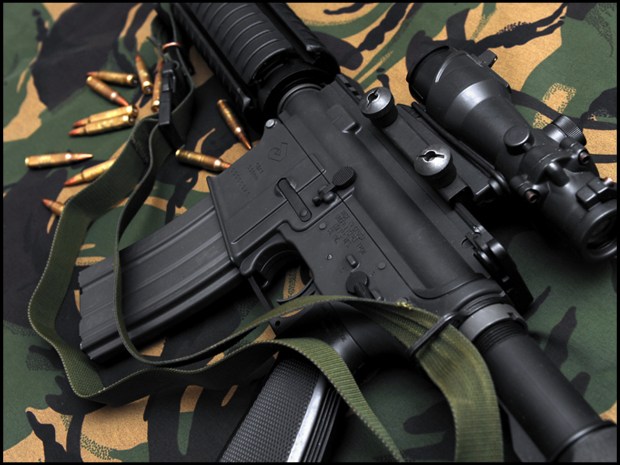
The fact the trades said ‘C8A1’ wasn’t a big thing, so long as you had the ‘D’…
This is not nostalgia for a time of lower standards, nor a pat on the back for advancing from builds which by today’s standards might be considered crude. Rather it is related partly to let people who joined the scene later know just a smidge about how it used to be, and also to give a sense of perspective.
So back to the present, and the staggering quality of the entries into the L119 Owners Competition – evidence of how the scene now has a laser focus, and as one item is sourced and honed as a replica attention moves onto the next how things can be improved, how the envelope of what can be done with a toy gun is pushed. The hobby for people who build impression builds isn’t really about airsoft, it’s an exercise in creativity, research and craft which is somewhat tangential in its geekery. You can certainly look at the winners of the competition as examples of these high standards, but it might be even more informative to look at the staggeringly good builds which missed out, not to mention the judge’s builds – Rich and Andy, had they not agreed to judge, would both have been among the front runners.
This development of the hobby, the desire for accurate, beautiful, well researched builds is great, and a testament to the community, and it’s not so much that the builds are not better so much as the older builds laid the groundwork and sparked the interest in L119s.
It’s all a very cool and exciting place to be – but this brings me onto the real point of this article, after a very long meandering preamble:
Tribalism and Elitism.
This is nothing new – anyone who remembers the old forums also remembers the savage arguments, pissing contests, locked threads and silliness which came with them. The fact that via realsim events and impression groups more contributors actually know and have met each other has helped alleviate the issue somewhat, as does the fact Facebook is largely real names, it certainly isn’t as anonymous as forum handles. The issue has far from disappeared however.
Now there are different approaches to building replicas, and people follow one, or a combination of these approaches. Anything from directly cloning a reference picture, to putting your own spin on a build but using commonly referenced parts, to creative unique builds with a variety of accessories, so long as they’ve been pictured at least once. The Reptile House Blog wrote a piece trying to coin terms for these different approachesand while I might not be universally in line with every part of the article, it’s an astute attempt to categorise the common approaches. Adherents to these various methodologies do occasionally have a tendency to dismiss the other though, to draw a line and decide on what is and is not a valid approach.
This can get further rarefied if you begin to define various features as the hallmarks of a valid build. Such as use of real parts, or maybe it should be GBBR since electric rifles (AEGs/PTWs/NGRS) are all far more sterile in terms of operation and ‘feel’. .. Such delineation between valid and non valid builds very much about gatekeeping and trying to discredit other approaches, and is often a matter of very subjective personal preference, and can seem arbitrary.
My main bug-bear which the title makes an allusion to is the idea that an L119A2 replica should have a true monolithic receiver to be a valid build. A monolithic ‘integrated upper receiver’ is a hallmark of the L119A2, true; but so is firing 5.56, being a certain weight, being operated in a certain way, having a QD suppressor etc etc… The only way you have a truly valid build is by signing up, passing selection and being issued a true L119A2 out the armoury – anything else is a matter of interpretation and is part of the hobby.
I tend to view the validity of builds as a sliding scale, at one end you have the poorly researched monstrosity which you might only know is meant to be an L119 because the owner told you, and at the other you have the absolutely flawless build upon which the owner has lavished no end of attention, care and money.
Most people are trying to push their builds from one end toward the other, within the limitations of their budget, platform of choice and personal commitment to it – some people want their build to stand up to scrutiny from centimetres away under carefully composed photos, others want their builds to look the part from a few feet back when putting their boot through a door – and while one approach is undoubtedly more accurate than another, both are valid. I think most people into this niche segment of the hobby can if they are honest decide when a build is credible enough to be deemed a fair shot. It might not pay to be too scientific about this but I tend to look at these items:
– Is the build recognisable? This is pretty simple, looking at it, does it tick enough boxes that you know what it is meant to be, even it might not be all the way there.
– Does it stand up from a few feet away? Or alternatively the ‘squint test’… If the build were photographed in a semi believable setting, at a passable but not particularly great resolution, would it be instantaneously obvious it wasn’t real, or would it bear alittle bit of examination?
– Has a degree of care been taken to make is accurate? By this I mean if buying a suppressor for instance, have they gone for one of the several Surefire replicas, or have they gone for a KAC or AAC repro on ebay. It’s about the right choices being made where things have been acquired.
If it ticks those items, it’s a valid build, and the question is just how far along the scale of geekery and expense it can be pushed – how good can it be made?
So there are two options available for an L119A2 build, HAO and Angry Gun – and sadly is seems many seem to fall almost tribally into one or the other. At worst they dismiss the other approach:
“Angry Gun rails aren’t monolithic so anything using them isn’t a real L119A2 build, they cannot be redeemed and only the plebs who don’t care about accurate builds use them”
Or
“HAO builds are for people with too much money who use unreliable sewing machines and invariably make hipster builds”
Both the above are huge caricatures, granted, but I am sure people can recognise there is a degree to which both attitudes are present in the community – although I think I have probably seen more of the former. Every expression of something that vaguely fits the above template also gets the backs of those it is directed at up and exacerbates the issue as they swing more toward it’s equally unhelpful mirror image.
So a reflection upon the two A2 options about.

Picture Credit: HAO
HAO produce an upper and a full L119A2 kit which features a monolithic integrated upper receiver which is about as close as it’s possible to get to the real thing. The kit is only available for PTWs, although future MWS and possible GHK released have been rumoured.
Their A2 offerings are beautiful creations with an exceptionally high attention to detail which meshes with the obsessive attitudes of many L119 builders. The HAO kits have a substantial price tag before you even factor in a PTW, which is unsurprising given the quality of parts are the fact they can’t shift that many units comparatively, smaller more exclusive runs means higher prices.
The HAO upper receiver was first released in 2018, with the first batch released, while still an excellent iteration, having a few inaccuracies and details that weren’t quite there. These were pointed out by a number of enthusiasts, including myself, privately – while I never heard anything back from HAO the revised release addressed all the issues that I could see, and although I don’t own one since I am not a PTW user, the pictures and reviews from respected sources suggest it is as near flawless as possible. It is a triumph and I am disappointed they don’t currently produce them for a platform I use.
I must confess some discomfort with the ‘Beta Release’ moniker which was applied to the release of the first batch retroactively, only after issues were identified, but regardless the product on sale today is a testament to a craft and no compromise approach which certainly finds a home in the L119 build community. One of the disappointments with the HAO A2 products as it stands is simply that they are not available for more platforms, in particular demand in the L119 build community are favourites of the Marui NGRS and GHK – these are particularly popular on the realsim and impression scenes. It’s not really worth worrying over however, HAO will build for the platforms they want and it doesn’t remove from what is possible with the PTW for those who use them.
It’s also worth noting HAO produce a number of accessories and smaller parts which are compatible with different platforms, either with some small modification or a straight fit, a variety of which I have used in my builds and which are all great quality.
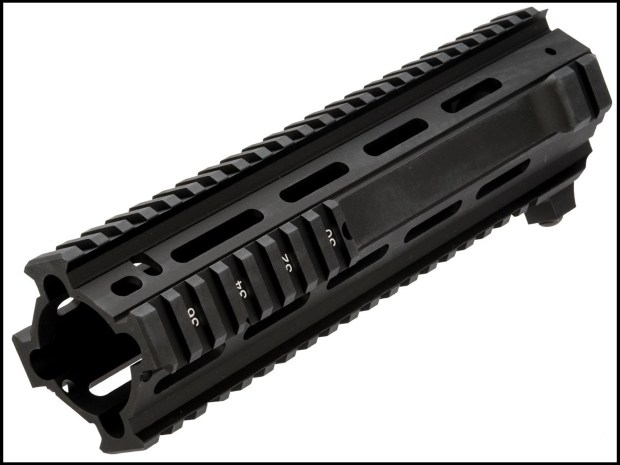
Picture Credit: Angry Gun/Evike
Angry Gun, by contrast, produce the L119A2 rail – which is fitted like a normal airsoft rail to the upper receiver of your choice via a hidden fixing system to allows L119A2 builds on almost any platform. This creative approach has allowed a profusion of A2 builds on people’s favourite systems, and they have been able to leverage economies of scale to get the price to a fairly accessible level, certainly if you’re building any L119 you have to accept it will be somewhat costly – the choice is between ‘quite expensive’ and ‘eyewateringly expensive’. Angry Gun are also the only option for the long 15.7in upper A2.
I was involved somewhat in the development of the Angry Gun rail, although I did not profit from it other than receiving a prototype rail free for comment and as a ‘thank you’, every subsequent AG rail I have bought I have done at full price. When I received the prototype Angry Gun rail I sent off a list of comments on them, privately, as I did of my observations on the HAO rail, some of which were acted on, but not all. As I understand it the cost of some of the modifications would have pushed the overall price of the product beyond where they wanted it to be. The Angry Gun, as you would expect with the different price points, market and approach to development is not as accurate as the HAO A2 (monolithic aside).
The approach of treating the A2 as a rail for maximum volume, maximum flexibility and a more controlled cost is that you end up with some interface issues. Structurally a solid bit of material will be stronger than an interface mechanism, and while I have had no issues with wobble on my AG rails, by their nature they will not be as resilient.
Furthermore the approach leads to a ‘double tooth’ issue in the RIS rail at the top, which while it can be covered with an optic, is a draw back. The RIS numbering and receiver finish will also not be perfectly integrated, so cerakote or painting may be preferable. Finally the receiver will require machining and milliput mods to get it to the true A2 shape which comes ‘as standard’ on a monolithic upper.
The L119 build community has mobilised to experiment and refine approaches to mitigate these issues as much as possible, but they are worth noting.
So my clickbait picture and title notwithstanding, I am going to state simply that I believe both approaches to building an A2 are valid, and both have produced some gorgeous builds, with the L119 Owners Club competition one of many examples of this, but far from the only one. Both approaches have lead to intriguing innovations, surprising creativity and most importantly fun and satisfaction for their owners – which is what it is all about, beside looking cool.
I would caution that if people who start on the impression build path are told the only option to produce something credible is a to drop at least a couple of thousand into a build to just cover off the basics, they won’t bother. They will either continue their builds without engaging with the wider community, and both will be poorer for it, or they will find something else to build. Either way the impression scene is starved of new members. I know if when I bought my partially build G&P L119A1 about nine years ago now I had been told I would need to have spent the amount I have now spent on my NGRS L119A1, I would never have bothered and never have produced a build I am now very proud of.
Furthermore as I alluded to earlier, drawing a line of validity on an arbitrary feature is not only unwise for the reasons I have listed but is also an approach which can be used to exclude your build on a variety of equally arbitrary criteria.
To be clear this is not an argument for lower standards per say, I am aware I run a group which is notorious for having high standards and probably taking builds too seriously. I believe great builds should be rightly praised for how good they are – but that dismissing something as not valid should be based on less arbitrary criteria than the product used its construction and more on the more subjective quality is shows. Because that build will almost certainly progress and I am sure almost all of the people with great builds about today has a photo or two of a ‘proto’ version somewhere.
It is also worth noting that without the early L119 products, including Army Code’s and PerrMike’s, we might not have had the market for Warlord or Begadi, we then might not have had the community of committed builders to make either the Angry Gun rail or HAO set or any of the various 556SA suppressor replicas at all viable. The suffocation of a scene down into a small handful, with high barriers to entry in terms of both time and money will eventually lead to the withdrawal of any market support. At the moment L119 builds remain a still under served market, but it’s only by keeping the community going that that remains the case.
So at the end of my meandering reflections on an element of the scene I have been musing upon a while, I think it worth reiterating that it is note a huge community, and there’s some great stuff that goes on within it. Occasional arguments crop up about all sorts of things, but HAO v AG is certainly one of those which really isn’t worth is.
TL:DR
Give peace a chance…
So I am back after over a year away from the blog – and while I am not going to be a prolific poster, I am not going to leave it so long again. In case anyone cares I’ve been abit preoccupied with a promotion at work and having bought a first house that was very much a ‘fixer upper’. In that time I have half finished a handful of articles, so I might look at finishing off a couple more.
All pictures have been used without permission. I hope the respective owners will be okay with such use in light of the intent behind the article and the on balance overwhelmingly positive views on all the products and builds pictured.
